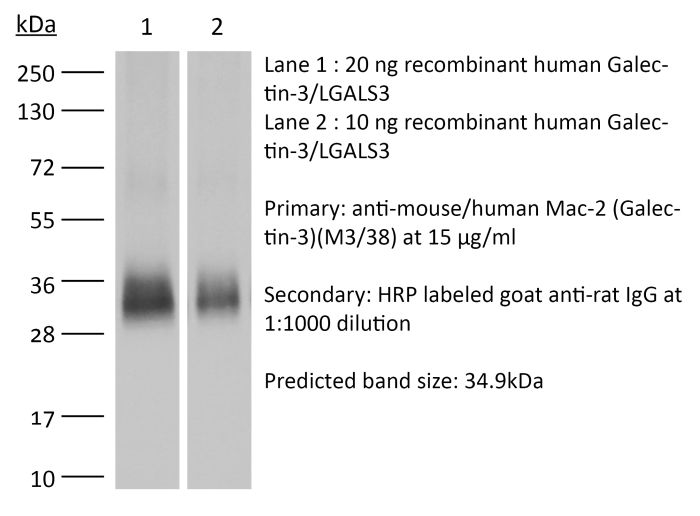InVivoMAb anti-mouse/human Mac-2 (Galectin-3)
Product Details
The M3/38 monoclonal antibody reacts with human and mouse Mac-2. Mac-2, also known as galectin-3 is a β-galactoside-binding lectin that is expressed in several tissues including the digestive and urogenital tracts, lungs, blood, kidneys, and heart. Mac-2 is highly expressed in myeloid cells and fibroblasts, as well as in epithelial and endothelial cells. Several different regulatory functions have been attributed to Mac-2 including cellular growth, proliferation, apoptosis, differentiation, cellular adhesion, tissue repair, inflammation, tissue fibrosis and angiogenesis. Mac-2 is implicated in the pathogenesis of several diseases, including organ fibrosis, chronic inflammation, cancer, atherosclerosis, and other cardiovascular diseases.Specifications
| Isotype | Rat IgG2a, κ |
|---|---|
| Recommended Isotype Control(s) | InVivoMAb rat IgG2a isotype control, anti-trinitrophenol |
| Recommended Dilution Buffer | InVivoPure pH 7.0 Dilution Buffer |
| Conjugation | This product is unconjugated. Conjugation is available via our Antibody Conjugation Services. |
| Immunogen | C57BL/6 mouse macrophage glycoproteins |
| Reported Applications |
Western blot Immunofluorescence Immunohistochemistry (paraffin) Immunoprecipitation |
| Formulation |
PBS, pH 7.0 Contains no stabilizers or preservatives |
| Endotoxin |
<2EU/mg (<0.002EU/μg) Determined by LAL gel clotting assay |
| Purity |
>95% Determined by SDS-PAGE |
| Sterility | 0.2 µm filtration |
| Production | Purified from cell culture supernatant in an animal-free facility |
| Purification | Protein G |
| Molecular Weight | 150 kDa |
| Storage | The antibody solution should be stored at the stock concentration at 4°C. Do not freeze. |
Recommended Products
Immunohistochemistry (paraffin)
Pedersen K, Nielsen MA, Juul-Madsen K, Hvid M, Deleuran B, Greisen SR. (2023). "Galectin-3 interacts with PD-1 and counteracts the PD-1 pathway-driven regulation of T cell and osteoclast activity in Rheumatoid Arthritis" Scand J Immunol 97(2):e13245. PubMed
Rheumatoid arthritis (RA) is an autoimmune disease characterized by joint inflammation and bone erosions. The glycosylated programmed death-1 (PD-1) receptor plays an important role in regulating immune responses and maintaining tolerance. In this study, we focus on two features observed in RA: impaired PD-1 signalling and Galectin-3 (Gal-3) upregulation. We hypothesize that Gal-3 binds PD-1 and PD-1 ligands, potentially contributing to impaired PD-1 signalling. PD-1 and Gal-3 levels in RA synovial fluid (SF) and plasma were evaluated by ELISA. PD-1 and Gal-3 interaction was examined by Surface Plasmon Resonance and ELISA. PD-1, PD-L1 and Gal-3 expression on mononuclear cells from SF and peripheral blood as well as fibroblast-like synoviocytes were examined by flow cytometry. Effects of Gal-3 and PD-L1 on osteoclast formation was evaluated by tartrate-resistant acid phosphatase assay. We show that Gal-3 binds PD-1 and PD-L1. Results demonstrated high expression of PD-1 and Gal-3 on mononuclear cells, especially from SF. Gal-3 inhibited PD-1 signalling when PD-L1 was present. Furthermore, a role of Gal-3 in osteoclast formation was observed in vitro, both directly but also through PD-1:PD-L1 inhibition. Effects of Gal-3 on the PD-1 signalling axis are proposed to be inhibitory, meaning high Gal-3 levels in the complex synovial microenvironment are not desirable in RA. Preventing Gal-3's inhibitory role on PD-1 signalling could, therefore, be a therapeutic target in RA by affecting inflammatory T cell responses and osteoclasts.
Immunofluorescence
Melo FH, Butera D, Junqueira Mde S, Hsu DK, da Silva AM, Liu FT, Santos MF, Chammas R. (2011). "The promigratory activity of the matricellular protein galectin-3 depends on the activation of PI-3 kinase" PLoS One 6(12):e29313. PubMed
Expression of galectin-3 is associated with sarcoma progression, invasion and metastasis. Here we determined the role of extracellular galectin-3 on migration of sarcoma cells on laminin-111. Cell lines from methylcholanthrene-induced sarcomas from both wild type and galectin-3(-/-) mice were established. Despite the presence of similar levels of laminin-binding integrins on the cell surface, galectin-3(-/-) sarcoma cells were more adherent and less migratory than galectin-3(+/+) sarcoma cells on laminin-111. When galectin-3 was transiently expressed in galectin-3(-/-) sarcoma cells, it inhibited cell adhesion and stimulated the migratory response to laminin in a carbohydrate-dependent manner. Extracellular galectin-3 led to the recruitment of SHP-2 phosphatase to focal adhesion plaques, followed by a decrease in the amount of phosphorylated FAK and phospho-paxillin in the lamellipodia of migrating cells. The promigratory activity of extracellular galectin-3 was inhibitable by wortmannin, implicating the activation of a PI-3 kinase dependent pathway in the galectin-3 triggered disruption of adhesion plaques, leading to sarcoma cell migration on laminin-111.
Western Blot, Immunoprecipitation
Rosenberg I, Cherayil BJ, Isselbacher KJ, Pillai S. (1991). "Mac-2-binding glycoproteins. Putative ligands for a cytosolic beta-galactoside lectin" J Biol Chem 266(28):18731-6. PubMed
Mac-2, a galactose-binding lectin secretion by activated macrophages, is the major non-integrin laminin-binding protein in these cells. Mac-2 is also expressed by epithelial cells in the intestine and kidney. We wished to identify intestinal glycoproteins other than laminin that have a high affinity for Mac-2 and that could be considered as candidate ligands or partners for this lectin in intestinal epithelium. Certain lines of human colon adenocarcinoma cells produce two Mac-2-binding glycoproteins (M2BP-1 and M2BP-2) that were identified by their avid association with Mac-2 following detergent lysis and immunoprecipitation. These glycoproteins do not share a common epitope with Mac-2, and the interaction between Mac-2 and these proteins is mediated through the carbohydrate-binding domain of Mac-2 and sugar moieties on M2BP-1 and M2BP-2. M2BP-1 (98 kDa) and M2BP-2 (70 kDa) were purified by immunoaffinity chromatography and were specifically eluted with either galactose or lactose. Peptide maps revealed that M2BP-1 and M2BP-2 are structurally related. M2BP-1 is secreted and could conceivably associate with Mac-2 extracellularly. N-terminal sequence analysis of M2BP-2 suggests that these glycoproteins represent a unique subset of candidate ligands for this mammalian beta-galactoside lectin.



